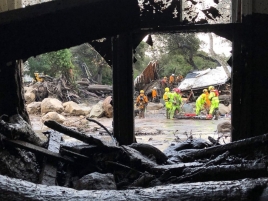6 dead after flooding and mudslides force thousands to flee in California

At least six people are dead and 25 are injured in California from weather-related incidents, the Santa Barbara County Sheriff's Office said today. The southern part of the state has been drenched with severe rain just weeks after several fires tore through the area.
Flash flooding, debris flow and mudslides are punishing the communities hit hard by the Thomas and La Tuna fires.
Because hundreds of thousands of acres were charred in the fires, the influx of water has nowhere to go.
In the affluent community of Montecito, some homes have been ripped from their foundations as a result of the torrential conditions. Montecito alone saw heavy rainfall in a short amount of time. About a third of the rain that has fallen in the last 24 hours in Montecito fell in just 5 minutes, according to the National Weather Service.
Local fire officials reported rescuing several people in the area, including a mother and her daughter who were caked in mud.
The Claffey family in Carpinteria was forced to evacuate its home last month. After moving back in, family members were told to evacuate again because of the rain.
"If our house was flooded it would be devastating. Absolutely devastating," Maureen Claffey told ABC News.
The record rains started coming down on Monday, soaking northern cities like San Francisco and Sacramento. First responders put on skies to help the stranded since many roads and thruways have become raging rivers.
A 14-year-old girl was "trapped for hours" in mud-soaked rubble on Hot Springs Road and then pulled to safety in a triumphant moment.
Power in the area has also been cut, according to ABC News affiliate KEYT.
More rescues were expected and evacuations are rising, officials said.
The worst of the storm will move inland, with the heavy rain letting up sometime around dinner time or even before, according to the National Weather Service. Flash flood watches will remain in effect across portions of Southern California, including Los Angeles and Santa Barbara until then.
So far, rainfall totals Tuesday afternoon range from 3 to 5 inches in the mountains in Ventura County and 2 to 3 inches in the mountains of Santa Barbara County, with higher totals within the areas burned by the Thomas fire in both counties.
Rainfall rates exceeding one inch per hour at times contributed to the damaging mudslides in portions of Southern California.
The weather has snarled drivers and first responders attempting to aid storm victims.
Routes in and out of Santa Barbara have been shut down from the south, and various roadways have been swallowed by the floods.
The only way into some of the washed-out homes is by air.
Ventura's Air Squad 6 dedicated helicopters to join Santa Barbara in the rescue effort.
Officials told ABC News they’ve been called to locations but they’re also stuck like thousands of motorists.
Excessive flooding and debris made some parts of Santa Barbara impassable.
Stranded drivers caught up in the rising water levels were being plucked from their vehicles to safer, dryer ground by emergency personnel relying on mostly aviation transportation.
And in creeks and other waterways, the treacherous floodwaters were moving at around 15 mph.
An additional 1 to 2 feet of snow is expected in the Sierra Nevada mountains.
Moving into the Plains
The storm system moves into the Great Plains on Wednesday and Thursday with winter storm watches and warnings already issued from Colorado to Wisconsin.
Locally, 6 to 12 inches are possible and this could be the biggest snowstorm of the season for places like the Twin Cities.
South of the storm, mild air could bring thunderstorms from Memphis to St. Louis.
January thaw in the East
Further east, a thawing has begun.
It's about 20 to 30 degrees warmer from Chicago to New York City than it was this past weekend as temperatures rise.
By Thursday, Chicago and Cleveland will be approaching 50 degrees for the first time since the middle of December.
New York City and Boston will be in the 50s by Friday. These temperatures will be 15 to 20 degrees above normal.
A cold blast will then sweep across the central U.S. on Thursday and Friday.
ABC News' M.L. Nestel, Julia Jacobo and Michael Kreisel contributed to this report.
Source: abcnews.go.com




